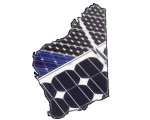Researchers from the University of Western Australia say Concentrated Solar Power (CSP) technologies have excellent potential to generate clean, renewable electricity for communities and mining operations throughout the state’s vast Wheatbelt.
Concentrated Solar Power differs to solar panel use in that in CSP, sunlight is concentrated via mirrors (heliostats) and focused onto pipes or some other sort of containment system containing water or a heat transfer medium. Steam is produced, or the heat is then used to create steam which is then piped to spin a turbine; much the same as what occurs in coal fired powered generation.
In a CSP based facility, heat can also be stored for electricity generation after dark and on days when the sun doesn’t shine by using a heat storage system such as a molten salt battery.
While CSP requires the use of water to create the steam, closed systems have been developed where much of the water used is recycled – an important advance given the shortage of water in semi-arid areas.
Assistant Professors Julian Clifton and Bryan Boruff of UWA’s School of Earth and Environment say small scale parabolic dish forms of CSP can provide a local, renewable alternative to non-renewable energy sources transmitted from outside the area. Large scale mining operations could benefit from medium scale CSP and any surplus electricity generated could help provide for residential needs of towns like Kalgoorlie
The researchers say similar research should be conducted in other areas where rural economic growth is being restrained by issues including outdated electricity infrastructure.
The final report, entitled "Assessing the potential for Concentrated Solar Power development in rural Australia", is available from the Wheatbelt Development Commission by calling the WDC on (08) 9622 7222
Source
Related:
Solar panel rebate information













































